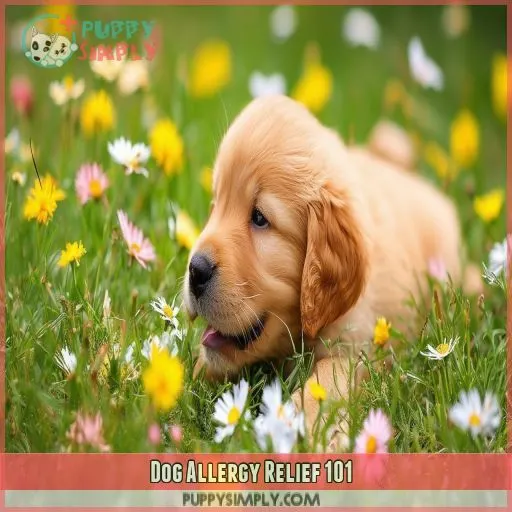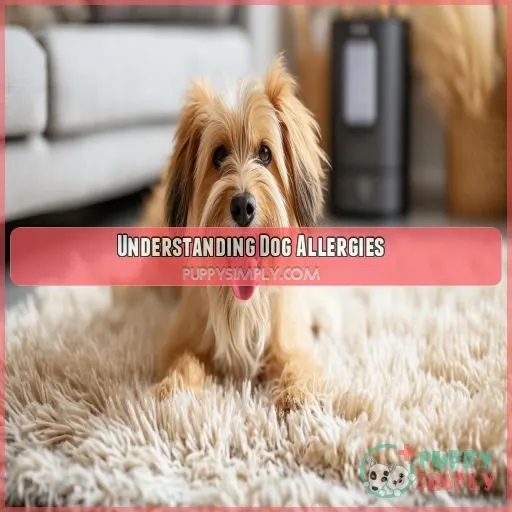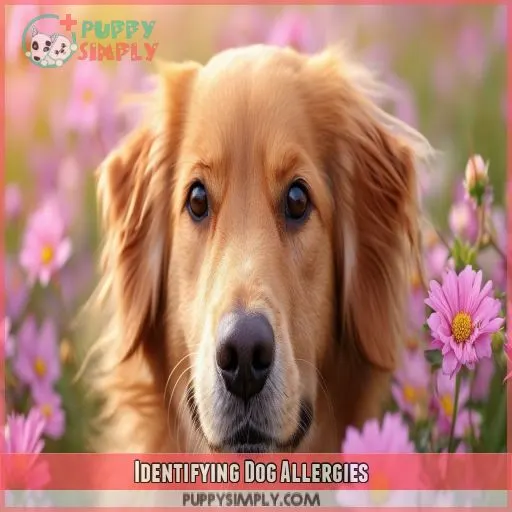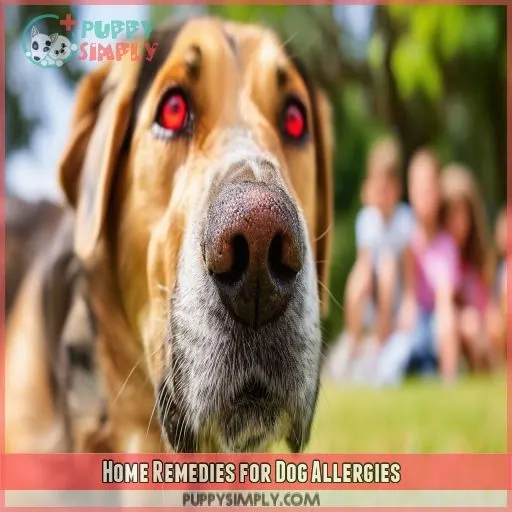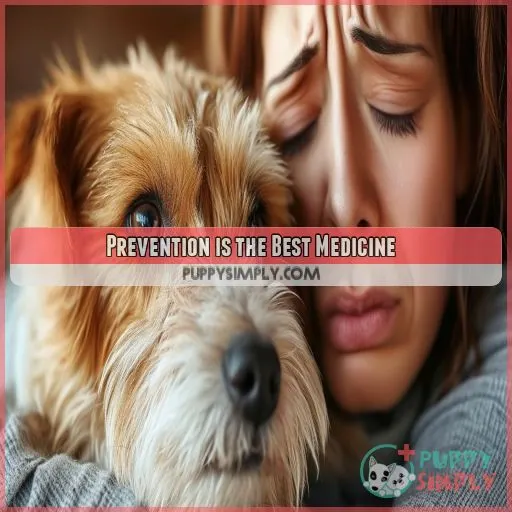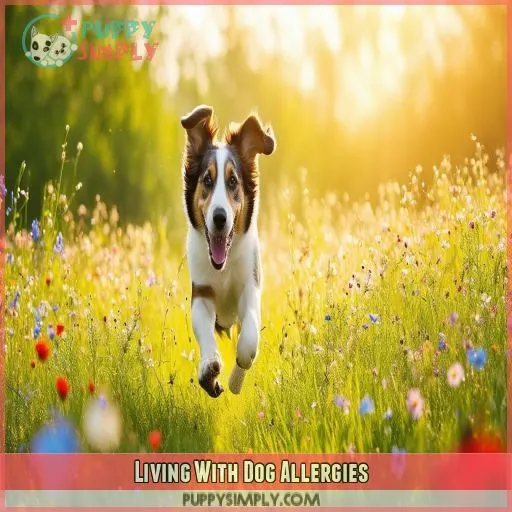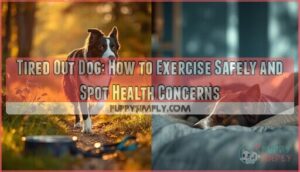This site is supported by our readers. We may earn a commission, at no cost to you, if you purchase through links.

If your furry friend is among them, you’re in the right place. We’ve got a ton of dog-friendly allergy relief methods that actually work.
From natural remedies to cutting-edge treatments, we’ll help you find the right fit.
Say goodbye to sniffles and scratches, and hello to tail-wagging fun.
Get ready to take control of your pup’s allergies and reclaim those carefree days at the park.
Table Of Contents
- Key Takeaways
- Dog Allergy Relief 101
- Top 7 Dog Allergy Relief Products
- Understanding Dog Allergies
- Identifying Dog Allergies
- Home Remedies for Dog Allergies
- The Most Common Allergy in Dogs
- When to See the Vet
- Prevention is the Best Medicine
- Alternative Allergy Treatments
- Living With Dog Allergies
- Frequently Asked Questions (FAQs)
- Conclusion
Key Takeaways
- Don’t let allergies put your pup in the doghouse! From natural remedies to vet-approved treatments, there’s a whole toolkit to help your furry friend ditch the itch and get back to tail-wagging adventures.
- Home is where the heart is, so make it allergy-friendly too! Regular cleaning, air purifiers, and hypoallergenic bedding can turn your pad into a sneeze-free paradise for your four-legged companion.
- Food for thought: Your dog’s diet could be the culprit behind those pesky allergies. Exploring hypoallergenic options or trying an elimination diet might just be the secret sauce to soothe your pup’s tummy troubles.
- When in doubt, bark up the right tree! Consult your vet if symptoms persist or worsen. They’re the real top dogs when it comes to diagnosing and treating your canine’s allergies, ensuring your best friend stays healthy and happy.
Dog Allergy Relief 101
Is your dog constantly scratching, sneezing, or dealing with tummy troubles? It’s time to step up and become their allergy-busting sidekick. Get ready to wave goodbye to those sniffles and hello to fun-filled days with your four-legged companion.
Common Symptoms of Dog Allergies
Allergies in dogs can manifest in a variety of ways, some more obvious than others. Here are the common symptoms to keep an eye out for:
- Itching, Scratching, and Licking: Excessive itching, scratching, and licking are often the first signs that your furry friend is dealing with allergies.
- Skin Problems: Keep an eye out for hair loss, hot spots, and skin infections.
- Ear Infections: Red, swollen ears with discharge can indicate allergies.
Diagnosing Dog Allergies
If you’re concerned your dog might’ve allergies, the first step is recognizing the signs and symptoms. Keep an eye out for common allergy symptoms like excessive itching, scratching, licking, chewing, hair loss, ear infections, eye irritation, sneezing, coughing, or gastrointestinal issues.
Once you’ve spotted these symptoms, it’s time to confirm your suspicions with a professional. Consult a veterinarian to discuss your observations and determine the next steps. They might recommend allergy testing to identify specific triggers, especially if your dog’s symptoms are persistent or severe.
Managing Dog Allergies
Managing dog allergies is all about finding the right balance of treatments and lifestyle changes. Here’s a crash course to get you started on the road to sniffle-free fun.
First things first: always consult a veterinarian before administering any medication to your furry friend. They’ll help you identify the specific allergens and tailor a treatment plan. This might include antihistamines like Benadryl, but these only work for around 30% of dogs.
For more targeted relief, prescription medications like nonsteroidal immunosuppressants (e.g., Apoquel) or corticosteroids (e.g., Prednisone) can be used short-term. Natural remedies like omega-3 fatty acids or quercetin may also help manage symptoms.
Don’t forget the power of prevention! Regular dusting, dehumidifiers, and Air purifiers can reduce allergens in the environment, giving your dog a break from triggers.
Top 7 Dog Allergy Relief Products
If you’re looking for quick fixes to alleviate your pup’s allergies, we’ve got some solutions for you. From itch-busting tablets to tasty chews, we’ve rounded up the top seven dog-friendly allergy relief products that are sure to bring some sniffle-free fun back into your furry friend’s life.
1. Benadryl Allergy Relief Tablets
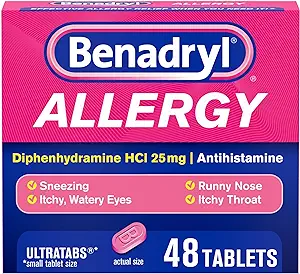
If your furry friend is dealing with allergies, Benadryl Allergy Relief Tablets could be a helpful option. These tablets are designed to relieve runny noses and sneezing caused by allergies or the common cold. They’re effective for both indoor and outdoor allergies and offer multi-symptom relief. Each tablet contains 25 mg of diphenhydramine HCl, an antihistamine that can help manage allergy symptoms. Benadryl is recommended for adults and children ages six and up, but always consult your veterinarian before giving it to your dog. Keep in mind that it may cause drowsiness, so monitor your pet’s response.
Best For: Benadryl Allergy Relief Tablets are best for dogs experiencing allergy symptoms like runny noses and sneezing.
- Relieves allergy symptoms like runny nose and sneezing.
- Effective for both indoor and outdoor allergies.
- Provides multi-symptom relief.
- May cause drowsiness.
- Not suitable for all dogs.
- Consult a veterinarian before use.
2. Dog Allergy Relief Chews
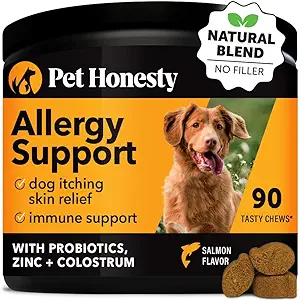
Dog Allergy Relief Chews are a popular choice for providing some comfort to your furry friend’s seasonal sniffles. These chews are designed to support your dog’s immune system and keep those pesky histamine levels in check.
But what’s in these chews that works its magic? Well, get this: they’re packed with natural ingredients like colostrum, salmon oil, turmeric, organic mushrooms, and probiotics. This dream team of ingredients gently soothes your pup’s skin issues and has ’em wagging their tails again in no time.
Now, when it comes to giving these chews to your dog, you gotta do it right. Start with half the suggested amount and then gradually increase. For example, small dogs (up to 25 lbs) get one chew per day, medium dogs (26-75 lbs) get two, and large dogs (over 75 lbs) get three.
Keep in mind that every dog’s different, so results may vary. Some dogs might hit it off with these chews, while others mightn’t see much of a change. And remember, while these chews are a great way to support your dog’s allergy relief, they’re not a substitute for professional veterinary care. So, if your pup’s allergies are causing major distress, it’s best to chat with your vet about other treatment options.
Best For: Dog owners looking for a natural way to support their dog’s seasonal allergies.
- Contains natural ingredients like colostrum, salmon oil, turmeric, and probiotics.
- May help reduce itching, licking, and scratching.
- Gentle and safe for most dogs.
- Individual results may vary.
- Some dogs may experience digestive upset (diarrhea).
- Not a cure-all for allergies, and professional veterinary care is still crucial.
3. Pet Hydrocortisone Spray Itch Relief

If your furry friend is battling skin issues, Pet Hydrocortisone Spray Itch Relief is a handy over-the-counter option. This spray contains 1% hydrocortisone, reducing inflammation, swelling, itching, and redness. It’s a great way to break the cycle of scratching and biting, providing relief from hot spots, bites, and skin conditions. This fragrance- and dye-free formula is made in the USA under strict quality controls. While effective for many pets, some users reported side effects like stomach irritation or depression. As with any new product, it’s best to consult your veterinarian, especially if your pet has sensitive skin.
Best For: Pets struggling with Itchy skin conditions like hot spots, bites, and allergies.
- Reduces inflammation, swelling, itching, and redness.
- Non-stinging, fragrance-free, and dye-free formula.
- Made in the USA with strict quality controls.
- Some users reported side effects like stomach irritation or depression.
- Contains propylene glycol, which may cause irritation in some pets.
- May not be effective for all pets and may require multiple applications.
4. Blue Buffalo Hydrolyzed Salmon Dog Food
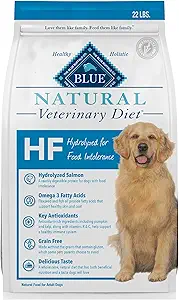
If your furry friend has food sensitivities, Blue Buffalo Hydrolyzed Salmon Dog Food could be their mealtime savior. This prescription dog food is specially formulated for dogs with special dietary needs. The star ingredient? Hydrolyzed salmon. It’s a readily digestible protein source that’s less likely to trigger an immune response in dogs with food allergies.
This natural dog food is packed with nutrition and flavor, and it’s veterinarian-approved. You won’t find any chicken or poultry by-product meals, corn, wheat, or soy in this bag. Instead, it’s loaded with Omega 3 fatty acids from fish oil and flaxseed to support healthy skin and a shiny coat.
You can buy this food in a 22-lb bag, which will last you a good while. While some dogs may experience a bit of gas with this food, many customers have seen improvements in their dog’s health, including relief from food sensitivities, skin allergies, and urinary tract issues. So, if you’re looking for a food intolerance solution, this Blue Buffalo formula might be just what the vet ordered.
Best For: Dogs with food sensitivities, allergies, and special dietary needs.
- Readily digestible hydrolyzed salmon protein.
- Contains Omega 3 fatty acids for healthy skin and coat.
- Veterinarian-approved formula.
- May cause gas in some dogs.
- Can be more expensive than other prescription foods.
- Not available in smaller bag sizes.
5. ARO EVE Air Purifier For Home
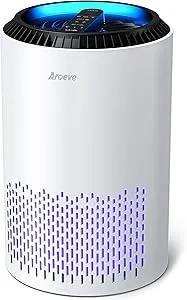
The ARO EVE Air Purifier is a compact yet powerful tool to improve your dog’s respiratory health. It boasts an impressive filtration system, capturing smoke, pollen, dander, and pet hair, leaving your home’s air cleaner and fresher. This purifier is ideal for small spaces up to 215 square feet, and its quiet operation, especially in sleep mode, makes it a discreet addition to your bedroom or living area.
One unique feature is the aroma pad, which lets you add essential oils for a pleasant fragrance. User reviews highlight its effectiveness in removing odors and improving air quality, making it a popular choice for pet owners seeking a simple yet effective solution to combat dog allergies.
Best For: Pet owners with small to medium-sized dogs and those seeking to improve air quality in their homes.
- Effective at filtering pet dander and allergens
- Quiet operation, especially in sleep mode
- Aroma pad allows for customization with essential oils
- Can be smaller than expected
- Some users have reported dust accumulation issues
- Inner mechanisms may become gummed up with dust, causing noise
6. Coconut Oil for Dogs and Cats
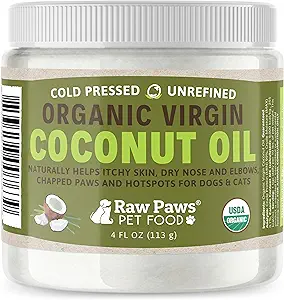
Coconut oil is a versatile product with multiple benefits for your furry friend. It soothes and heals dry skin, providing itch relief for irritated paws, noses, elbows, ears, and wrinkles. Coconut oil is also great for cat acne chin treatment. Besides skin benefits, coconut oil supports immunity, improves digestive health, and can be used as a breath freshener and dog toothpaste. You can apply it directly to your pet’s skin, massage it into their fur, or add it to their food. With its various uses and benefits, coconut oil is a handy addition to your pet care routine.
Best For: This product is best for pet owners looking for a natural, versatile solution to improve their dog or cat’s skin health, digestion, and overall well-being.
- Multi-purpose: Soothes dry skin, supports immunity, improves digestion, and acts as a breath freshener.
- Natural and Safe: 100% organic, cold-pressed, unrefined, and free of harmful chemicals and preservatives.
- Easy to Use: Can be applied directly to the skin, massaged into fur, or added to food.
- Potential for Mess: Can be messy to apply, especially on fur.
- Limited Shelf Life: Unrefined coconut oil has a shorter shelf life than refined versions.
- May Not Be Suitable for All Pets: Some pets may be allergic to coconut oil.
7. Bragg Organic Apple Cider Vinegar
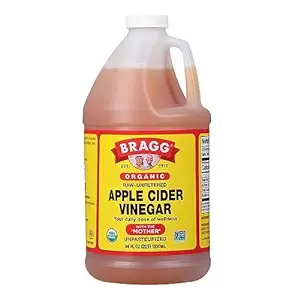
Bragg Organic Apple Cider Vinegar is a versatile product with a range of benefits for your dog’s allergy relief. It’s made from organically grown apples and is raw and unfiltered, retaining the beneficial "Mother" substance. This cloudy goodness is packed with enzymes and bacteria that support digestion and overall health. With its tangy flavor, it’s great for dressings, marinades, and even natural cleaning. Some users also praise its effectiveness in reducing sugar cravings. It’s a certified organic, Non-GMO, and Kosher product, ensuring the highest quality for your furry friend’s well-being.
Best For: Bragg Organic Apple Cider Vinegar is best for those seeking a natural and versatile product for various uses, including digestive support, allergy relief, and natural cleaning.
- Made from organically grown apples, unfiltered, and contains the "Mother" for added benefits.
- Versatile uses for cooking, cleaning, and even supporting overall health.
- Certified organic, Non-GMO, and Kosher, ensuring high quality and ethical production.
- May not be suitable for all dogs, especially those with sensitive stomachs.
- Can be too acidic for some uses, requiring dilution or careful application.
- Limited scientific evidence to support all claimed health benefits.
Understanding Dog Allergies
Understanding dog allergies is key to providing your furry friend with much-needed relief. Allergies in dogs are more common than you might think, and they can cause a whole host of uncomfortable symptoms.
Environmental Allergens
Environmental allergens are the most common cause of dog allergies, and they can make your furry friend absolutely miserable. These allergens include:
- Pollen
- Dust mites
- Mold
- Grass
- Flea saliva
But don’t worry, there are ways to help your pup find relief!
Food Allergens
Food allergens can also cause allergies in dogs, in addition to environmental allergens.
Typical food allergens include chicken, beef, dairy, and wheat. These allergens can cause a range of symptoms, including digestive issues, skin problems, and others.
To identify food allergies, work with your vet to put your dog on a food elimination trial with a hypoallergenic diet.
Limited-ingredient diets can also help reduce potential allergens.
Once identified, remove the offending ingredient and consider a long-term hypoallergenic diet.
Flea Allergens
Not Just a Pest, But a Serious Itch
Flea saliva can trigger allergic reactions in dogs, causing intense itching and skin problems. These tiny pests may seem harmless, but for dogs with allergies, they’re a recipe for discomfort.
If your dog is constantly scratching, licking, or chewing at their skin, fleas could be the culprit. It’s important to inspect your dog’s coat regularly for these unwelcome guests and take preventative measures to keep them at bay.
Contact Allergens
Contact allergens are another common trigger for dog allergies. These are materials that your dog comes into direct contact with, such as:
- Fabrics: Some dogs may be allergic to certain types of fabric, like wool or synthetic materials.
- Plants: Exposure to certain plants, such as poison ivy or oak, can cause allergic reactions in dogs.
- Chemicals: Allergic reactions can be triggered by chemicals in cleaning products, pesticides, or other household items.
- Metals: Metals like nickel, commonly found in collars, tags, and bowls, can cause contact allergies in dogs.
Identifying and removing these allergens from your dog’s environment can provide significant relief from allergy symptoms.
Inhaled Allergens
Inhaled allergens are things your dog breathes in, like smoke, dust, or perfume. These airborne irritants can trigger allergic reactions, leading to respiratory symptoms like sneezing, coughing, and wheezing. It’s like when someone sprays perfume, and you sneeze uncontrollably—except for your dog, it might be dust or smoke causing the issue.
Identifying Dog Allergies
If your furry friend is itching, scratching, and sneezing, it’s time to play detective. Identifying dog allergies involves keeping an eye out for telltale signs and symptoms. From skin problems to gastrointestinal issues, we’ll help you spot the clues and figure out what’s bugging your pup, so they can get back to their playful, itch-free self.
Skin Problems
Identifying Dog Allergies
Itchy, scratchy, and hair today, gone tomorrow? If your furry friend is battling skin issues, it could be a sign of allergies. Keep an eye out for these common skin-related symptoms:
- Excessive itching, scratching, and licking
- Chewing and biting at the skin
- Hair loss or bald patches
- Redness, irritation, and inflammation
- Bumps, rashes, or sores
If you spot any of these issues, it’s time to take action. Consult a veterinarian to rule out other skin conditions and determine if allergies are the culprit.
Ear Infections
If your furry friend is battling allergies, keep an eye out for ear infections.
Redness, swelling, and discharge from the ears can signal that your pup’s immune system is reacting to allergens.
This is especially concerning as ear infections can be painful and lead to hearing issues if left untreated.
Don’t let your dog suffer in silence – take them to the vet for a proper diagnosis and treatment plan.
Eye Irritation
Just like humans, dogs can experience eye irritation as an allergy symptom. It’s like they say, the eyes are the window to… well, allergies in this case! Keep an eye out for watery eyes, redness, and discharge. These symptoms can indicate that your furry friend is battling allergies.
Sneezing and Coughing
If your furry friend is sneezing and coughing, it could be a sign of allergies. Here’s how to identify and tackle these issues:
- Respiratory symptoms: Besides sneezing and coughing, keep an ear out for wheezing.
- Common allergens: Pollen, dust, and smoke are common triggers.
- Prevention: Minimize exposure to known allergens.
- Treatment: Consult your vet about antihistamines or try OTC options like Benadryl (with guidance).
- Air quality: An air purifier can help reduce airborne allergens in your home.
Gastrointestinal Issues
Besides respiratory symptoms, allergies can also affect your dog’s tummy. Gastrointestinal issues may manifest as vomiting, diarrhea, or gas. These symptoms can be a real pain, especially if your furry friend has a sensitive stomach to begin with.
| Signs of Gastrointestinal Issues | Potential Causes |
|---|---|
| Vomiting | Food allergies, intolerance |
| Diarrhea | Food allergies, intolerance |
| Gas | Food allergies |
If you suspect a food allergy, it’s time to play detective and investigate your dog’s diet. Work with your vet to identify potential triggers and rule out other health conditions.
Home Remedies for Dog Allergies
If your furry friend is battling allergies, there’s no need to panic. You can try some simple home remedies to bring them relief. From identifying and avoiding allergens to incorporating dietary changes and soothing baths, we’ll explore easy, effective ways to help your dog find comfort.
Avoid Allergens
Keeping your dog allergy-free is important for their health. Here are some practical tips to help minimize your furry friend’s exposure to allergens:
- Pollen Patrol: Keep an eye on pollen counts, especially during spring and fall. Limit outdoor time when pollen levels are high, and wipe down your dog’s paws and coat after walks to remove pollen.
- Dust Mite Defense: Dust frequently to remove dust mites, and consider using a dehumidifier to reduce their population.
- Air Purifier Advantage: Invest in an air purifier to help capture airborne allergens, creating a safer indoor environment for your dog.
- Pet Grooming: Regular bathing and brushing can reduce allergens on your dog’s fur and skin, including pollen, dust, and dander. It also keeps their coat healthy and shiny!
Diet Changes
Food allergies in dogs are less common than environmental allergies, but they can still cause discomfort. If you suspect your furry friend is reacting to something in their diet, it’s time to take action. Here’s how to deal with food allergies and restore your dog’s health:
- Consult a Vet: Chat with your veterinarian about your concerns. They can help determine if a food allergy is the culprit and guide you toward the right diet.
- Try a Hypoallergenic Diet: Switch to a hypoallergenic diet, which means opting for novel protein sources your dog hasn’t been exposed to before. This could be novel meats like kangaroo or venison, or even something more exotic like duck or rabbit.
- Explore Limited-Ingredient Foods: Simplify mealtimes by offering your dog food with fewer ingredients. This makes it easier to identify potential allergens and gives you better control over what your dog consumes.
Air Purifiers
Air purifiers are a fantastic way to reduce airborne allergens in your home, creating a healthier environment for you and your furry friend.
Here’s a table to help you choose the right air purifier for your space:
| Room Size | Air Changes per Hour | Air Changes per Day |
|---|---|---|
| Small | 4 ACH | 96 ACD |
| Medium | 5 ACH | 120 ACD |
| Large | 6 ACH | 144 ACD |
Oatmeal Baths
Oatmeal baths are a great way to soothe your dog’s itchy skin. Oatmeal has natural soothing properties, and it can help to reduce inflammation and irritation.
Here are some benefits of using oatmeal baths to treat your dog’s allergies:
- Natural remedy: Oatmeal is a safe, natural ingredient that’s gentle on your dog’s skin.
- Soothing relief: It helps calm itchy, irritated skin, providing comfort to your furry friend.
- Anti-inflammatory: Oatmeal’s natural properties reduce inflammation, aiding in your dog’s overall allergy relief.
- Easy to use: Simply add oatmeal to warm water and let your dog soak, making bath time a soothing experience.
Antihistamines
Antihistamines like Benadryl can help ease your pup’s allergy woes, especially if they’re more prone to hay fever symptoms like sneezing and watery eyes.
But don’t go solo on this one—consult your vet first to get the green light on dosage and safety.
While generally safe, side effects may occur, so keep an eye out for any unusual behavior.
Alternatives like Zyrtec and Claritin are also options, but again, only with your vet’s blessing.
The Most Common Allergy in Dogs
If your dog is itchy and sneezy, it’s likely they’ve got allergies. Just like us, dogs can be allergic to all sorts of things, but some triggers are more common than others. Let’s sniff out the usual suspects and get to the root of your pup’s problems.
The most common allergies in dogs include pollen, dust mites, mold, grass, and—you guessed it—flea saliva. These allergens can cause a range of symptoms, from itchy skin to sneezing fits, and they’re more common than you might think.
Pollen
As the seasons change, so do your dog’s allergy triggers. Pollen is the most common allergy in dogs, and it’s important to know how to keep your furry friend sniffle-free during allergy season. Here’s the lowdown on pollen allergies in dogs:
- Seasonal Changes: Pollen allergies in dogs tend to flare up during spring and fall. Keep an eye on your dog during these seasons, as the increased pollen counts can trigger allergic reactions.
- Allergy Triggers: Different dog breeds may be allergic to specific types of pollen. Grass pollen, for example, is a common trigger for skin irritation in some dogs.
- Symptoms: Just like us, dogs can experience watery eyes, sneezing, and coughing due to pollen allergies. Keep an eye out for excessive itching, scratching, and hair loss, which could indicate skin allergies.
- Prevention: During allergy season, consider limiting your dog’s outdoor exposure during peak pollen times, usually early morning and late afternoon. When they do go outside, wipe down their paws and coat with a damp cloth to remove pollen.
Dust Mites
Dust mites are tiny creatures that thrive in dust and can trigger allergies in dogs all year round.
They’re like tiny ninjas, lurking in carpets, bedding, and upholstery, causing sneezing, itching, and other allergy symptoms.
To combat these pesky critters, regular cleaning and dusting are key.
A dehumidifier can also help keep their population in check by reducing the moisture they love.
Mold
Mold can be a sneaky troublemaker for your furry friend.
These microscopic spores love damp areas and can trigger allergies year-round.
Keep an eye out for black mold in your home, as it’s particularly nasty.
Don’t let your pup’s sniffer lead them to trouble – tackle mold removal head-on.
Grass
Is your furry friend scratching up a storm every time they hit the lawn?
Grass allergies might be the culprit behind those seasonal woes. Pollen from various grasses can trigger itchy paws and sneezes galore.
Don’t let your pup’s playground become a minefield! With some smart lawn care and a few tricks up your sleeve, you can help your canine companion romp freely without the aftermath.
Flea Saliva
- Flea bites trigger an allergic reaction in sensitive dogs
- Just one bite can cause intense itching and discomfort
- Symptoms include red, inflamed skin and hair loss
- Keeping fleas at bay is key to preventing allergic reactions
- Consult your vet for effective flea prevention strategies
When to See the Vet
While home remedies can work wonders for mild allergies, there are times when your furry friend needs professional help. Knowing when to consult your vet can make all the difference in managing your dog’s allergies effectively and keeping those tail-wagging adventures sniffle-free.
Severe Symptoms
When your furry friend’s allergies turn into a four-alarm fire, it’s time to call in the cavalry.
If you spot excessive scratching, hair loss, or difficulty breathing, don’t wait for things to snowball. These red flags signal it’s time to get the vet’s expertise.
Your quick action can be a real lifesaver!
Persistent Symptoms
If your furry friend’s allergies are sticking around like an uninvited houseguest, it’s time to call in the pros. Persistent symptoms can be a real pain in the tail, and your vet’s expertise might be just what the doctor ordered. Here are some signs it’s time to seek professional help:
- Your pup’s scratching more than a DJ at a rave
- Home remedies aren’t cutting the mustard
- You’re worried about your dog’s quality of life
Don’t let allergies rain on your parade – get the relief your best friend deserves!
New Symptoms
While persistent symptoms can be frustrating,
new ones are a real red flag. If your furry friend suddenly starts scratching like crazy or develops unusual bumps,
it’s time to hit the panic button—or better yet, the vet’s number. New symptoms could be your dog’s way of saying, "Hey, something’s not right!"
Don’t play detective; let the pros unravel this allergy mystery.
Underlying Conditions
Don’t let your furry friend suffer in silence!
Sometimes, what seems like allergies might be barking up the wrong tree. Underlying conditions can masquerade as allergic reactions, throwing you off the scent.
Keep your eyes peeled for persistent symptoms or sudden changes in behavior.
If your pup’s discomfort persists despite your best efforts, it’s time to leash up and head to the vet for a thorough check-up.
Diagnosis and Treatment
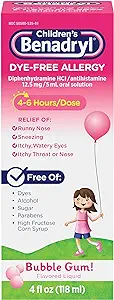 View On Amazon
View On Amazon - Skin scraping to check for pesky parasites
- Blood tests to sniff out any systemic issues
- Allergy tests to identify the troublesome triggers
- Food trials to rule out dietary villains
Prevention is the Best Medicine
If your furry friend has allergies, it’s best to get ahead of the problem. By taking steps to minimize allergen exposure and boost your dog’s overall health, you can help keep those pesky sneezes and itches at bay.
Remove Allergens From the Environment
Ready to wage war on allergens?
Your furry friend‘s freedom from sniffles starts at home!
Dust mites and pollen don’t stand a chance against your trusty vacuum. Make it a weekly ritual to banish these microscopic troublemakers.
Invest in an air purifier – it’s like a bodyguard for your pup’s lungs.
Creating a pet-friendly home isn’t just about comfy beds; it’s about clean air and itch-free paws!
Dietary Changes
You’re what you eat, and so is your furry friend!
If Fido’s feeling under the weather, it might be time to shake up his kibble routine.
Switching to a hypoallergenic diet can work wonders for allergic pups.
Start with an elimination trial to pinpoint the culprit ingredients.
Consult your vet before making any drastic changes.
Your pooch’s tummy will thank you!
Regular Bathing
Regular bathing is another powerful weapon in your allergy-fighting arsenal.
It’s like giving your furry friend a spa day that doubles as an allergen-busting mission!
Aim to bathe your pup every 1-2 weeks, using a gentle, hypoallergenic shampoo.
For long-coated dogs, consider more frequent baths.
Lukewarm water is best, and don’t forget to dry thoroughly.
Your pooch mightn’t love bath time, but their itch-free skin will thank you!
Hypoallergenic Dog Foods
While regular baths keep allergens at bay,
you can take it a step further with hypoallergenic dog food.
It’s like giving your pup’s immune system a vacation!
These special chow options typically feature novel proteins and limited ingredients,
making it easier to pinpoint and avoid food triggers.
Keep an eye out for brands that use hydrolyzed proteins –
they’re the secret sauce for sensitive stomachs!
Alternative Allergy Treatments
When traditional treatments aren’t cutting it, alternative allergy relief methods can offer your furry friend some much-needed comfort. From food elimination trials to natural remedies, these approaches might just be the ticket to help your pup ditch the itch and get back to tail-wagging happiness.
Food Elimination Trials
While prevention is key, sometimes you need to play detective with your pup’s diet.
Enter food elimination trials – your secret weapon against food allergies. Think of it as a culinary adventure for your furry friend.
You’ll switch to a hypoallergenic diet, then slowly reintroduce potential allergens. It’s like solving a tasty puzzle, with your dog’s health as the prize.
Patience is key, but the sniffle-free results are worth it!
Environmental Changes
You’ve tried food trials, but Fido’s still scratching?
Time to tackle your home environment. Think of it as spring cleaning for your pup’s comfort!
Invest in air purifiers to zap airborne allergens, and vacuum religiously with HEPA filters.
Don’t forget to wash Fido’s bedding weekly in hot water.
Natural Remedies
Looking for natural remedies to soothe your pup’s allergies? You’re barking up the right tree! These holistic options can help your furry friend find relief without breaking the bank. Here are some tail-wagging choices to check out:
- Quercetin: Nature’s antihistamine, great for reducing inflammation
- Omega-3 fatty acids: Fish oil supplements for a shiny coat and itch relief
- Nettle leaf: A natural antihistamine with anti-inflammatory properties
- Probiotics: Boost your dog’s gut health to support their immune system
Homemade Remedies
Feeling adventurous? Try these homemade remedies for your pup’s allergies. They’re like a secret weapon in your arsenal against those pesky sniffles and itches. Just remember, while these DIY treatments can offer relief, they’re not a substitute for professional care.
| Remedy | Ingredients | Use |
|---|---|---|
| Soothing Spray | Apple cider vinegar, water | Mist on itchy spots |
| Calming Tea Soak | Chamomile tea bags, warm water | Soak affected areas |
| Anti-itch Paste | Turmeric, coconut oil | Apply to irritated skin |
Always patch test first and consult your vet before trying new treatments.
Epipens
While homemade remedies can work wonders, sometimes you need the big guns. Enter Epipens – your dog’s superhero in a syringe. These life-savers treat severe allergic reactions (anaphylaxis) in a flash. Here’s what you need to know:
- Keep it close: Stash an Epipen in your pup’s emergency kit
- Learn the signs: Recognize anaphylaxis symptoms like difficulty breathing
- Act fast: Administer the injection in your dog’s thigh
- Follow up: Rush to the vet after using an Epipen
Living With Dog Allergies
Living with a dog with allergies doesn’t have to be a constant battle. With the right lifestyle adjustments and personalized care, you can help your furry friend enjoy a sniffle-free, tail-wagging life full of fun and adventure.
Lifestyle Adjustments
Living with a dog with allergies isn’t a walk in the park, but with some lifestyle tweaks, you can make it a breeze. Here’s a quick guide to creating a dog-friendly, allergy-safe haven:
| Adjustment | Benefits |
|---|---|
| Daily brushing | Removes allergens, bonding time |
| Regular baths | Reduces allergen buildup |
| Allergy-free zone | Safe space for symptom relief |
| Stress reduction | Less scratching, more tail wags |
| Exercise routine | Boosts immunity, reduces anxiety |
Personalized Care
Your furry friend’s allergies are as unique as their pawprint.
Tailor a personalized care plan that fits like a glove. Mix and match treatments, from dietary tweaks to environmental changes, until you find your pup’s sweet spot.
Keep a "sneeze diary" to track triggers and responses.
Unleash Sniffle-free Fun
Now that you’ve got your pup’s allergies under control, it’s time to have some sniffle-free fun!
Take your furry friend for a romp in allergy-friendly parks, or snuggle up for movie nights with air purifiers humming.
With the right tools in your doggy toolkit, you’re ready to create pawsome memories without the pesky itch and scratch.
Frequently Asked Questions (FAQs)
Can dogs develop new allergies as they age?
Yes, your furry friend can develop allergies at any age. Just like humans, dogs’ immune systems change over time. You might notice new symptoms or reactions to things that didn’t bother them before. Keep an eye out!
How do seasonal changes affect dog allergy symptoms?
As seasons dance, so do your dog’s allergies. You’ll notice flare-ups during spring and fall when pollen counts soar. Keep an eye out for increased scratching, sneezing, or paw licking. Seasonal changes can intensify your pup’s symptoms.
Are certain dog breeds more prone to allergies?
Yes, some breeds are more allergy-prone. You’ll find Labrador Retrievers, Golden Retrievers, and German Shepherds topping the list. It’s like they’ve won the genetic lottery for sneezes! But don’t worry, any breed can develop allergies.
Can stress or anxiety worsen a dogs allergies?
Yes, stress and anxiety can exacerbate your dog’s allergies. When your furry friend’s nervous, their immune system goes into overdrive, making allergic reactions worse. It’s like they’re scratching an itch with worry! Keep them calm to help manage symptoms.
Do indoor-only dogs still develop environmental allergies?
Yes, indoor dogs can still develop environmental allergies. You’d be surprised, but your home’s a hotbed of allergens like dust mites, mold, and cleaning products. Even that cozy carpet can harbor triggers for your furry friend’s sensitivities.
Conclusion
Worried that managing your dog’s allergies is too complex? Don’t fret!
With these dog-friendly allergy relief methods, you’re well-equipped to tackle sniffles and scratches head-on.
Stay vigilant, consult your vet when needed, and don’t hesitate to try natural remedies alongside conventional treatments.
By implementing these strategies, you’ll be back to enjoying carefree park days in no time.
Your dog’s tail will be wagging with sniffle-free joy!

